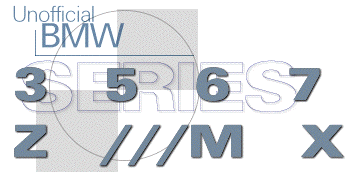|
Ron Stygar Carl Buckland Dale Beuning Forums Help
Date: Thu, 08 Jun 2000 06:36:51 PDT This is an email reply that I found very helpful with my unstable at high speeds steering problem. Thanks Danesh! 2 emails: johnathan, the offset, forged rims came on the 95 lightweights here in the US and were an option in other markets. essentially, the problem is this: a 7.5 inch wide rim should not be used for any tire wider than a 225. Michelin told BMW, BMW's marketers refused to listen. the 3.0 M3's handling was heavily panned in europe due to its disconnected feel (blame that front subframe/get an X-brace) and tricky handling on the limit (it nreaks traction with little warning.) the staggered wheels contribute to stability on the limit b/c the tire's tread is more squarely planted to the road surface (for more consistent traction even under camber variations) and less sidewall flex (because the sidewall is not 'pre-loaded' or 'pinched' on the rim. i've been using 225/45R17s all around for nearly a year no with no regrets, save the decrease in accelerationdue to the effective final drive ratio change. my goal was to make the car more like the miata in that i prefer a car that can be driven on the limit and beyond and then brought back gently to one that eeks out more grip on the skidpad but is less precise at the limit. the later cars (the 3.2s) used 225/45s up front and 245/40s in the rear for a number of reasons. the advantages were decreased impact harshness, greater rim protection, more friendly breakaway. the disadvantages were that the car was more difficult to steer with the throttle and less communicative than previous cars (keep in mind that the spring, shock and sway bar rates were tuned with the larger, staggered etup in mind, as was the final drive ratio.) i've driven M3s on a variety of tires by now, my favorite setup would be 225/45s all around (with a 3.23 or 3.38 differential) or 235/40R17 all around with the 3.15 or 3.23 diff. the 3.2s benefit the most from this size because of their advantage in gearing and their sway bar diameters being set up for less understeer when the same tire is used all around. in your original post, you complained of high speed stability problems: there are a few things that can contribute to this: 1) too wide a tire for the rim, 2) alignment settings, and 3) tire design. in your case it seems obvious the alignment shopis at fault -- i went through six alignments to try and correct one bad one. make sure things match side to side (toe and camber) with a full tank and someone of equivalent weight in the driver's seat and that the thrust angle is at zero. my alignment guy pointed out to me that it's very easy to capture the right settings on a printout by jiggling the car and then recording the numbers so it's imperative that the person you're dealing with knows what the M3 should feel like and what works best for your intende application. i've found that less is more with the toe in on the M3, especially in the rear. rear camber is ideally around 1.7 to 1.8 degrees negative, while front camber is dictated by the condition of your front suspension. if you go in complaining that the car wanders at high speeds, the alignment shop may simply increase front toe in. my front end was dead on, it was the rear that was causing my uneasiness. my alignment guy pointed out that the front end dictates where the car is pointed, the rear where it wants to go... my guy charged $120 for the alignment and the bushing swap, but that was at a shop rate. i'd expect you'd pay somewhere in the mid to high 100s as a retail customer. make sure you use the bushings from the late prodiction cars; the 95 ones are apparently still available and arent up to the torque demands of the M3. good luck and let me know if you need anything else.
daanesh |

